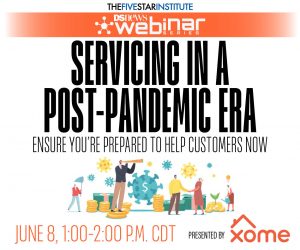 DS News recently held the webinar, “Servicing in a Post-Pandemic Era: Ensure You’re Prepared to Help Customers [1],” powered by Xome [2], discussing servicer preparedness and how the industry is readying itself for the upcoming wave of homeowners coming out of forbearance plans.
DS News recently held the webinar, “Servicing in a Post-Pandemic Era: Ensure You’re Prepared to Help Customers [1],” powered by Xome [2], discussing servicer preparedness and how the industry is readying itself for the upcoming wave of homeowners coming out of forbearance plans.
Moderated by David Wharton, Interim Editor-in-Chief for The Five Star Institute [3], panelists Shawn Miller, VP, Head of Business Development for Xome [2] and Ramie Word, SVP of Default Servicing for Mr. Cooper [4] covered education, assistance, and expedited options for the disposition or sale of properties prior to foreclosure, and covered programs and processes to assist homeowners through the process ending in a dignified exit.
As recently reported by the Mortgage Bankers Association (MBA) [5], there are approximately two million U.S. homeowners currently in forbearance plans. This week, the number of homes in foreclosure declined for the 15th consecutive week, now comprising just 4.16% of all mortgage volume.
“This current housing market is much different than the great financial crisis,” said Miller. “Homeowners have more resources, support, and options—including historically low interest rates—providing the opportunity to reduce your loan and mortgage payments through a refinance.”
Servicers have been working hand-in-hand with the government and regulators to guide homeowners through these new unchartered waters. Just as the pandemic hit the nation with unprecedented situations never before faced, homeowners who were impacted financially through unexpected pandemic-related job loss were able to take solace in the fact that mortgage servicers were there for them to provide options.
“We really had to act quickly to create products and offer guidance,” said Word. “We also had to shift our resources where we could better support the customer. For the last few years at Mr. Cooper, we have really grown our performing portfolio and really were not seeing the same delinquent transfers as we had years prior. We were able to partner with the GSEs [government-sponsored enterprises], the CFPB [Consumer Financial Protection Bureau], and the FHFA [Federal Housing Finance Authority] to make sure we had the right solutions in place for the customer, making them aware of these solutions.”
Options the industry presented to homeowners seeking relief included the Standalone Partial Claim, the Owner-Occupant Modification, the Combo Partial Claim and Loan Modification, and the FHA Home Affordable Modification Program (HAMP). Despite the struggles faced, the number one priority noted by Word is to keep the customer in their home.
“A big misconception for those not in the industry, and I deal with these customer calls on a weekly basis, they think in today’s environment, the servicer is out to foreclose and get their property back,” said Word. “We know that’s not the environment we are in. The number one priority is to keep the customer in the home. Being able to partner with the GSEs and CFPB speaks volumes to the differences between the financial crunch of 10-12 years ago to where we are at now. We are able to have a dialogue and get answers to grey area questions, so we are all marching down the same path together.”
The focus shifted to the future and what lies ahead as the foreclosure moratoria deadline of June 30 rapidly approaches.
“As an industry, we can navigate through these challenging times together, while keeping the homeowner’s interest at heart,” said Miller.
The U.S. economy continues to gain momentum, and with that trend, mortgage servicers are finding more and more exiting forbearance plans, and resuming their payments. According to the latest from the U.S. Department of Labor [6], the advance figure for seasonally adjusted initial unemployment claims was 376,000, a decrease of 9,000 from the previous week's level of 385,000, and the lowest level for initial claims since March 14, 2020 when it was 256,000.
“As some of the programs begin to expire, we don’t want to lose sight of options available to keep customers in their home,” said Word. “We will keep a heavy focus on digital, giving the customer the ability to self-serve, and also have the support here if they need us.”
One byproduct of the pandemic is that many servicers had to pivot and shift their assets to other departments and train their workforce on other aspects of the industry. Diversifying the workforce became a plus for most as firms now had employees who could transition to other roles and fill in gaps where needed once the moratoria is lifted to handle an impending influx of volume.
“We have the ability to flex team members and move them from the more default servicing-oriented businesses to support more of our origination-oriented businesses,” said Miller. “They have been helping with the large volume on the origination side, and it’s great for those employees from a career perspective as they learn more about the entire mortgage ecosystem as a whole.”
Click here [1] to view a recording of the webinar, "Servicing in a Post-Pandemic Era: Ensure You’re Prepared to Help Customers."